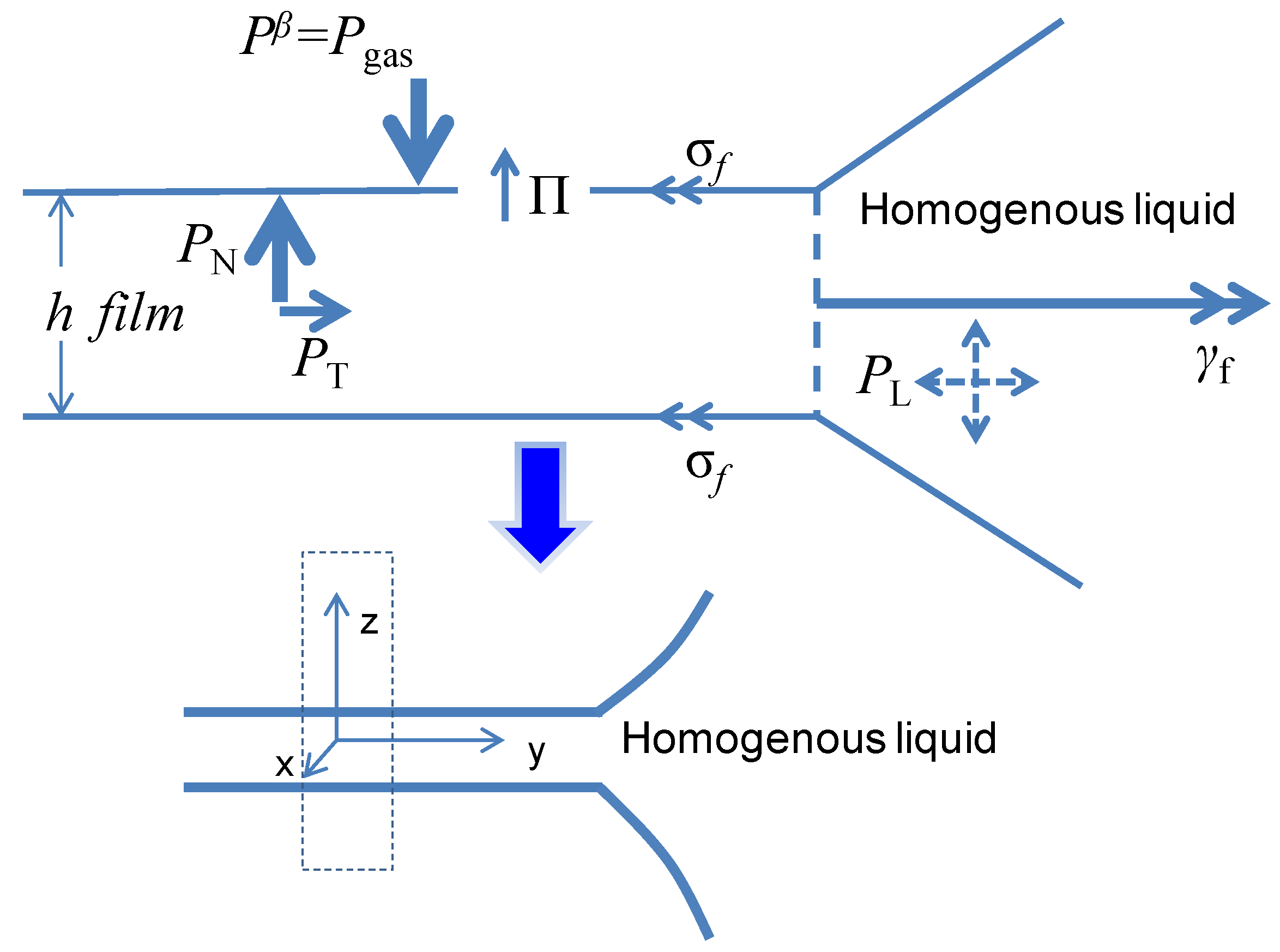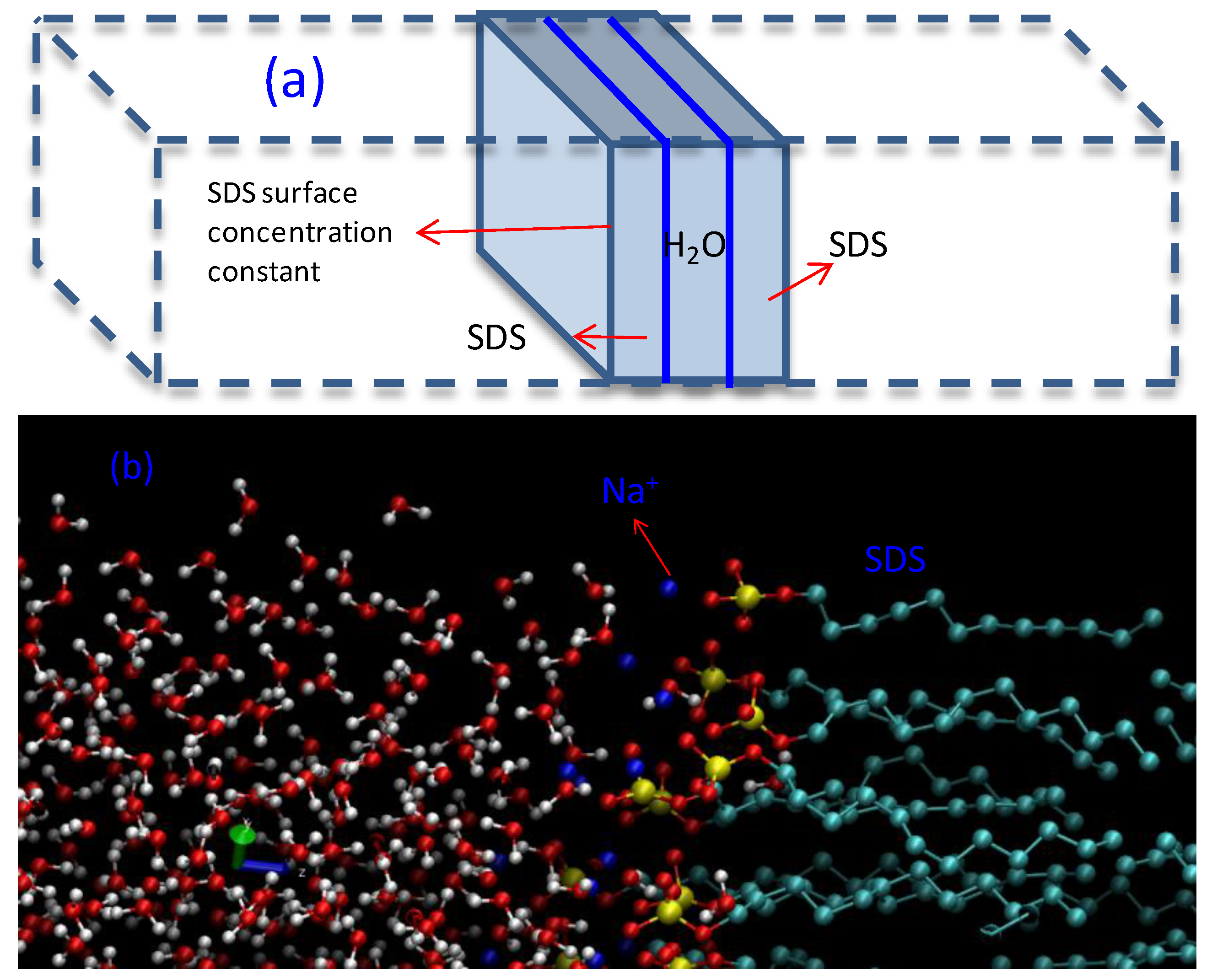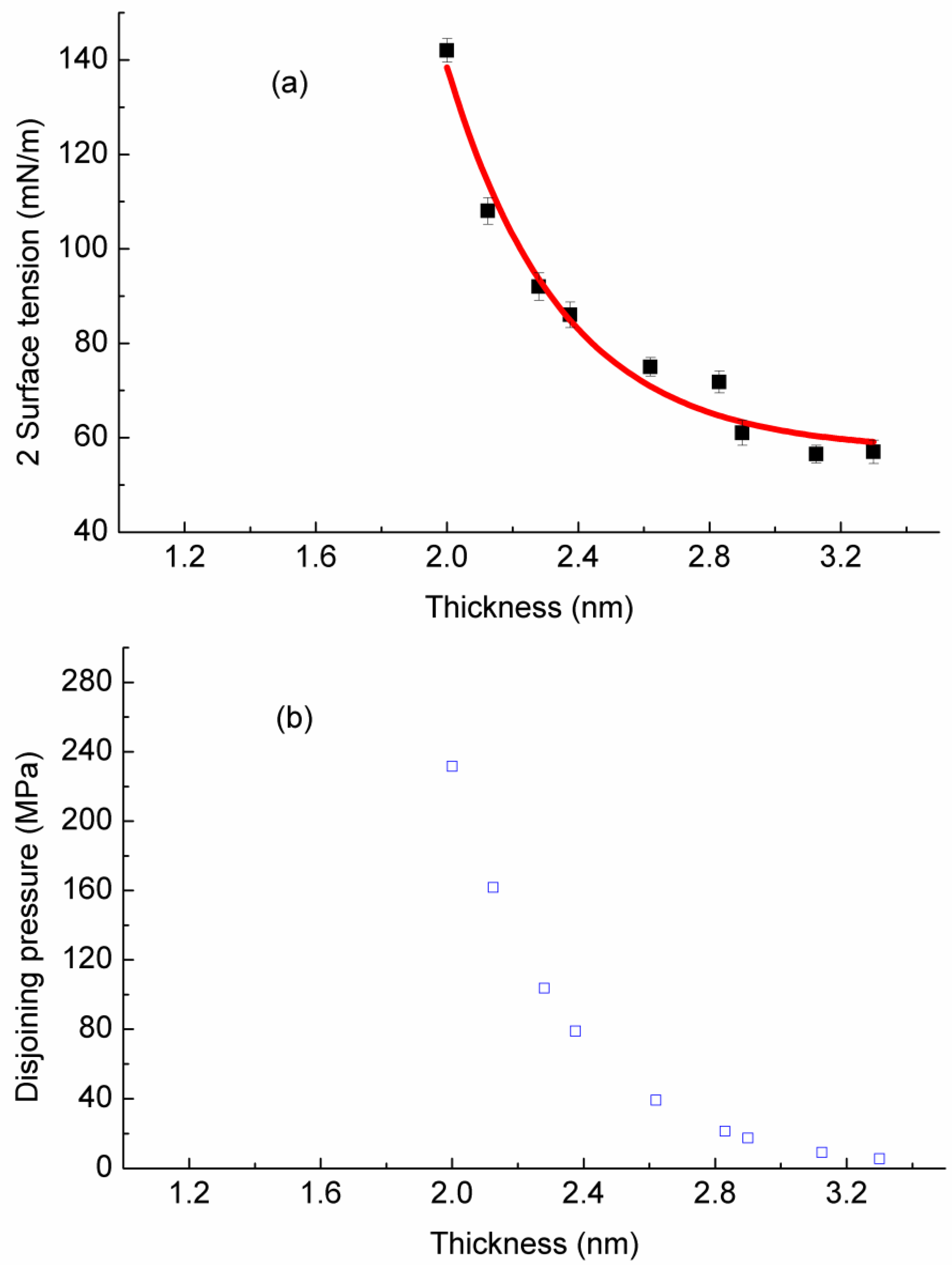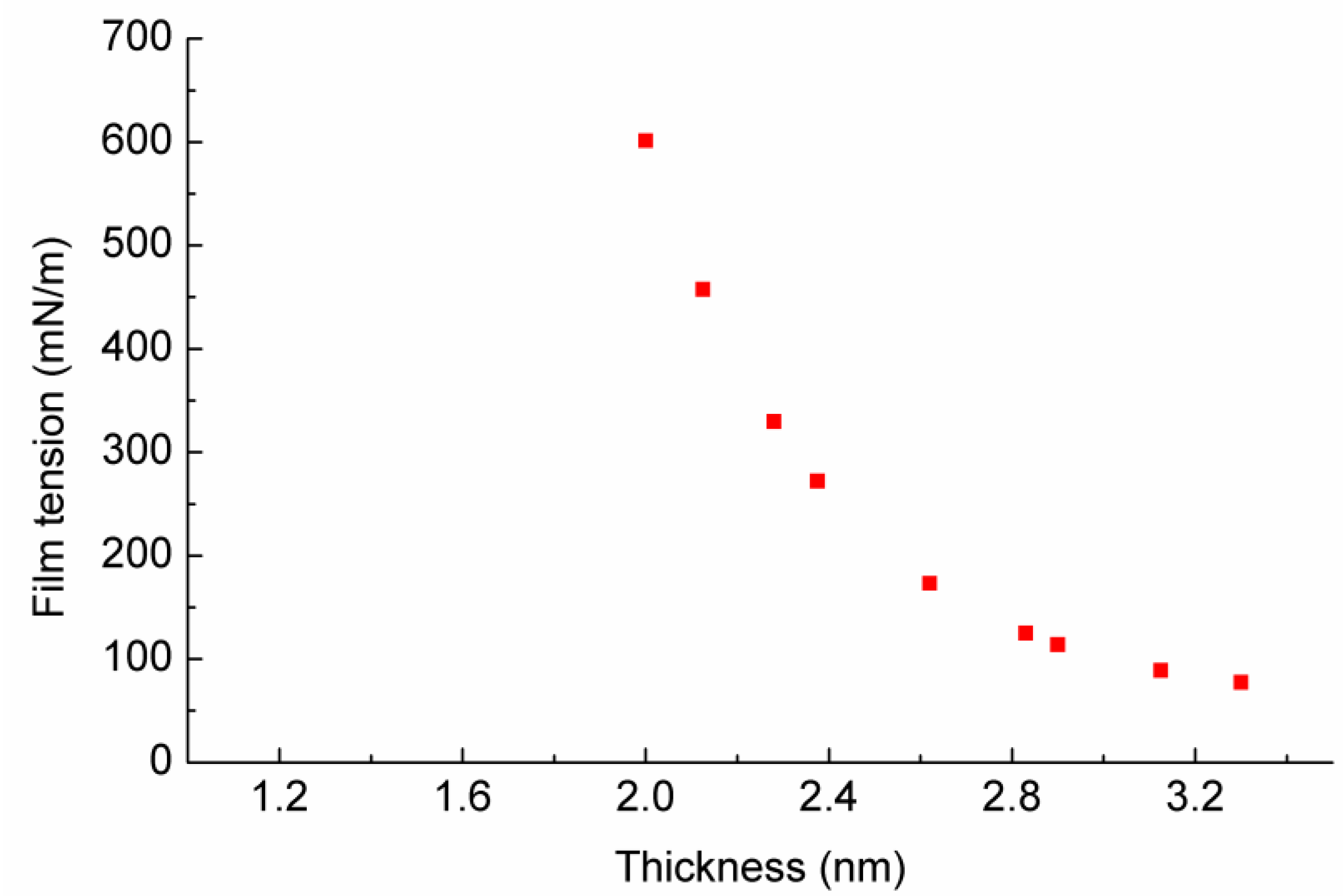Surface Interaction of Nanoscale Water Film with SDS from Computational Simulation and Film Thermodynamics
Abstract
:1. Introduction
2. Methodology
2.1. Theoretical Approach from Film Thermodynamics
2.2. Computational Modeling System
3. Results and Discussion
3.1. Disjoining Pressure Isotherms
3.2. Film Tension
4. Conclusions
Acknowledgments
Author Contributions
Conflicts of Interest
References
- Barthélémy, P.; Cuvillier, N.; Chaudier, Y.; Benattar, J.-J.; Pucci, B. Stability of Newton black films of highly fluorinated non-ionic surfactants. J. Fluor. Chem. 2000, 105, 95–102. [Google Scholar] [CrossRef]
- Muruganathan, R.M.; Müller, H.J.; Möhwald, H.; Krastev, R. Effect of Headgroup Size on Permeability of Newton Black Films. Langmuir 2005, 21, 12222–12228. [Google Scholar] [CrossRef] [PubMed]
- Bergeron, V.; Waltermo, Å.; Claesson, P.M. Disjoining Pressure Measurements for Foam Films Stabilized by a Nonionic Sugar-Based Surfactant. Langmuir 1996, 12, 1336–1342. [Google Scholar] [CrossRef]
- Langevin, D.; Marquez-Beltran, C.; Delacotte, J. Surface force measurements on freely suspended liquid films. Adv. Colloid Interface Sci. 2011, 168, 124–134. [Google Scholar] [CrossRef] [PubMed]
- Ninham, B. On progress in forces since the DLVO theory. Adv. Colloid Interface 1999, 83, 1–17. [Google Scholar] [CrossRef]
- Wang, L.; Yoon, R.-H. Effect of pH and NaCl concentration on the stability of surfactant-free foam films. Langmuir 2008, 25, 294–297. [Google Scholar] [CrossRef] [PubMed]
- Paunov, V.N.; Dimova, R.I.; Kralchevsky, P.A.; Broze, G.; Mehreteab, A. The Hydration Repulsion between Charged Surfaces as an Interplay of Volume Exclusion and Dielectric Saturation Effects. J. Colloid Interface Sci. 1996, 182, 239–248. [Google Scholar] [CrossRef]
- Israelachvili, J.N.; Wennerstroem, H. Entropic forces between amphiphilic surfaces in liquids. J. Phys. Chem. 1992, 96, 520–531. [Google Scholar] [CrossRef]
- Hu, H.; Weinberger, C.R.; Sun, Y. Effect of Nanostructures on the Meniscus Shape and Disjoining Pressure of Ultrathin Liquid Film. Nano Lett. 2014, 14, 7131–7137. [Google Scholar] [CrossRef] [PubMed]
- Xu, B.; Chen, X. Liquid flow-induced energy harvesting in carbon nanotubes: A molecular dynamics study. Phys. Chem. Chem. Phys. 2013, 15, 1164–1168. [Google Scholar] [CrossRef] [PubMed]
- Zhan, H.; Zhang, G.; Tan, V.B.C.; Gu, Y. The best features of diamond nanothread for nanofibre applications. Nat. Commun. 2017, 8. [Google Scholar] [CrossRef] [PubMed]
- Jian, C.; Liu, Q.; Zeng, H.; Tang, T. Effect of Model Polycyclic Aromatic Compounds on the Coalescence of Water-in-Oil Emulsion Droplets. J. Phys. Chem. C 2017, 121, 10382–10391. [Google Scholar] [CrossRef]
- Jian, C.; Zeng, H.; Liu, Q.; Tang, T. Probing the Adsorption of Polycyclic Aromatic Compounds onto Water Droplets Using Molecular Dynamics Simulations. J. Phys. Chem. C 2016, 120, 14170–14179. [Google Scholar] [CrossRef]
- Taherian, F.; Marcon, V.; Bonaccurso, E.; van der Vegt, N.F.A. Vortex formation in coalescence of droplets with a reservoir using molecular dynamics simulations. J. Colloid Interface Sci. 2016, 479, 189–198. [Google Scholar] [CrossRef] [PubMed]
- Faraudo, J.; Bresme, F. Anomalous dielectric behavior of water in ionic newton black films. Phys. Rev. Lett. 2004, 92. [Google Scholar] [CrossRef] [PubMed]
- Faraudo, J.; Bresme, F. Origin of the short-range, strong repulsive force between ionic surfactant layers. Phys. Rev. Lett. 2005, 94. [Google Scholar] [CrossRef] [PubMed]
- Jang, S.S.; Goddard, W.A. Structures and properties of Newton black films characterized using molecular dynamics simulations. J. Phys. Chem. B 2006, 110, 7992–8001. [Google Scholar] [CrossRef] [PubMed]
- Yang, W.; Yang, X. Molecular Dynamics Study of the Influence of Calcium Ions on Foam Stability. J. Phys. Chem. B 2010, 114, 10066–10074. [Google Scholar] [CrossRef] [PubMed]
- Yang, W.; Yang, X. Molecular Dynamics Study of the Foam Stability of a Mixed Surfactant/Water System with and without Calcium Ions. J. Phys. Chem. B 2011, 115, 4645–4653. [Google Scholar] [CrossRef] [PubMed]
- Peng, T.; Nguyen, A.V.; Peng, H.; Dang, L.X. Quantitative Analysis of Aqueous Nanofilm Rupture by Molecular Dynamic Simulation. J. Phys. Chem. B 2012, 116, 1035–1042. [Google Scholar] [CrossRef] [PubMed]
- Peng, T.; Chang, T.-M. Molecular processes of ion effects on aqueous nanofilm rupture. J. Mol. Liq. 2014, 193, 139–151. [Google Scholar] [CrossRef]
- Winter, S.J. Computer Simulation of Free, Thin-Liquid Films and Disjoining Pressures; University of California: Berkeley, CA, USA, 1999. [Google Scholar]
- Bhatt, D.; Newman, J.; Radke, C. Molecular simulation of disjoining-pressure isotherms for free liquid, Lennard-Jones thin films. J. Phys. Chem. B 2002, 106, 6529–6537. [Google Scholar] [CrossRef]
- Bhatt, D.; Newman, J.; Radke, C. Molecular simulation of disjoining-pressure isotherms for free aqueous thin films. J. Phys. Chem. B 2003, 107, 13076–13083. [Google Scholar] [CrossRef]
- Bhatt, D.; Newman, J.; Radke, C. Monte Carlo simulations of disjoining-pressure isotherms for Lennard-Jones surfactant-stabilized free thin films. J. Phys. Chem. B 2004, 108, 13412–13418. [Google Scholar] [CrossRef]
- Peng, T.; Firouzi, M.; Li, Q.; Peng, K. Surface force at the nano-scale: Observation of non-monotonic surface tension and disjoining pressure. Phys. Chem. Chem. Phys. 2015, 17, 20502–20507. [Google Scholar] [CrossRef] [PubMed]
- Eriksson, J.C.; Toshev, B.V. Disjoining pressure in soap film thermodynamics. Colloids Surf. 1982, 5, 241–264. [Google Scholar] [CrossRef]
- Ivanov, I. Thin Liquid Films; CRC Press: Boca Raton, FL, USA, 1988; Volume 29. [Google Scholar]
- Radke, C.J. Film and membrane-model thermodynamics of free thin liquid films. J. Colloid Interface Sci. 2015, 449, 462–479. [Google Scholar] [CrossRef] [PubMed]
- Ivanov, I.; Toshev, B. Thermodynamics of thin liquid films. Colloid Polym. Sci. 1975, 253, 593–599. [Google Scholar] [CrossRef]
- Brown, D.; Neyertz, S. A general pressure tensor calculation for molecular dynamics simulations. Mol. Phys. 1995, 84, 577–595. [Google Scholar] [CrossRef]
- Abascal, J.L.; Vega, C. A general purpose model for the condensed phases of water: TIP4P/2005. J. Chem. Phys. 2005, 123. [Google Scholar] [CrossRef] [PubMed]
- Hess, B.; Kutzner, C.; Van Der Spoel, D.; Lindahl, E. GROMACS 4: Algorithms for highly efficient, load-balanced, and scalable molecular simulation. J. Chem. Theory Comput. 2008, 4, 435–447. [Google Scholar] [CrossRef] [PubMed]
- Van Der Spoel, D.; Lindahl, E.; Hess, B.; Groenhof, G.; Mark, A.E.; Berendsen, H.J.C. GROMACS: Fast, flexible, and free. J. Comput. Chem. 2005, 26, 1701–1718. [Google Scholar] [CrossRef] [PubMed]
- Lindahl, E.; Hess, B.; Van Der Spoel, D. GROMACS 3.0: A package for molecular simulation and trajectory analysis. J. Mol. Model. 2001, 7, 306–317. [Google Scholar] [CrossRef]
- Essmann, U.; Perera, L.; Berkowitz, M.L.; Darden, T.; Lee, H.; Pedersen, L.G. A smooth particle mesh Ewald method. J. Chem. Phys. 1995, 103. [Google Scholar] [CrossRef]
- Cornell, W.D.; Cieplak, P.; Bayly, C.I.; Gould, I.R.; Merz, K.M.; Ferguson, D.M.; Spellmeyer, D.C.; Fox, T.; Caldwell, J.W.; Kollman, P.A. A Second Generation Force Field for the Simulation of Proteins, Nucleic Acids, and Organic Molecules. J. Am. Chem. Soc. 1995, 117, 5179–5197. [Google Scholar] [CrossRef]
- Peng, T.; Chang, T.M.; Sun, X.; Nguyen, A.V.; Dang, L.X. Development of ions-TIP4P-Ew force fields for molecular processes in bulk and at the aqueous interface using molecular simulations. J. Mol. Liq. 2012, 173, 47–54. [Google Scholar] [CrossRef]
- Bélorgey, O.; Benattar, J.J. Structural properties of soap black films investigated by X-ray reflectivity. Phys. Rev. Lett. 1991, 66. [Google Scholar] [CrossRef] [PubMed]
- Christenson, H.K.; Bowen, R.E.; Carlton, J.A.; Denne, J.R.M.; Lu, Y. Electrolytes that Show a Transition to Bubble Coalescence Inhibition at High Concentrations. J. Phys. Chem. C 2007, 112, 794–796. [Google Scholar] [CrossRef]
- Marrucci, G.; Nicodemo, L. Coalescence of gas bubbles in aqueous solutions of inorganic electrolytes. Chem. Eng. Sci. 1967, 22, 1257–1265. [Google Scholar] [CrossRef]
- Craig, V.S.J.; Ninham, B.W.; Pashley, R.M. Effect of electrolytes on bubble coalescence. Nature 1993, 364, 317–319. [Google Scholar] [CrossRef]
- Craig, V.S.J. Bubble coalescence and specific-ion effects. Curr. Opin. Colloid Interface 2004, 9, 178–184. [Google Scholar] [CrossRef]
- Chen, M.; Lu, X.; Liu, X.; Hou, Q.; Zhu, Y.; Zhou, H. Molecular Dynamics Simulation of the Effects of NaCl on Electrostatic Properties of Newton Black Films. J. Phys. Chem. C 2012, 116, 21913–21922. [Google Scholar] [CrossRef]






© 2017 by the authors. Licensee MDPI, Basel, Switzerland. This article is an open access article distributed under the terms and conditions of the Creative Commons Attribution (CC BY) license (http://creativecommons.org/licenses/by/4.0/).
Share and Cite
Peng, T.; Li, Q.; Xu, L.; He, C.; Luo, L. Surface Interaction of Nanoscale Water Film with SDS from Computational Simulation and Film Thermodynamics. Entropy 2017, 19, 620. https://doi.org/10.3390/e19110620
Peng T, Li Q, Xu L, He C, Luo L. Surface Interaction of Nanoscale Water Film with SDS from Computational Simulation and Film Thermodynamics. Entropy. 2017; 19(11):620. https://doi.org/10.3390/e19110620
Chicago/Turabian StylePeng, Tiefeng, Qibin Li, Longhua Xu, Chao He, and Liqun Luo. 2017. "Surface Interaction of Nanoscale Water Film with SDS from Computational Simulation and Film Thermodynamics" Entropy 19, no. 11: 620. https://doi.org/10.3390/e19110620




